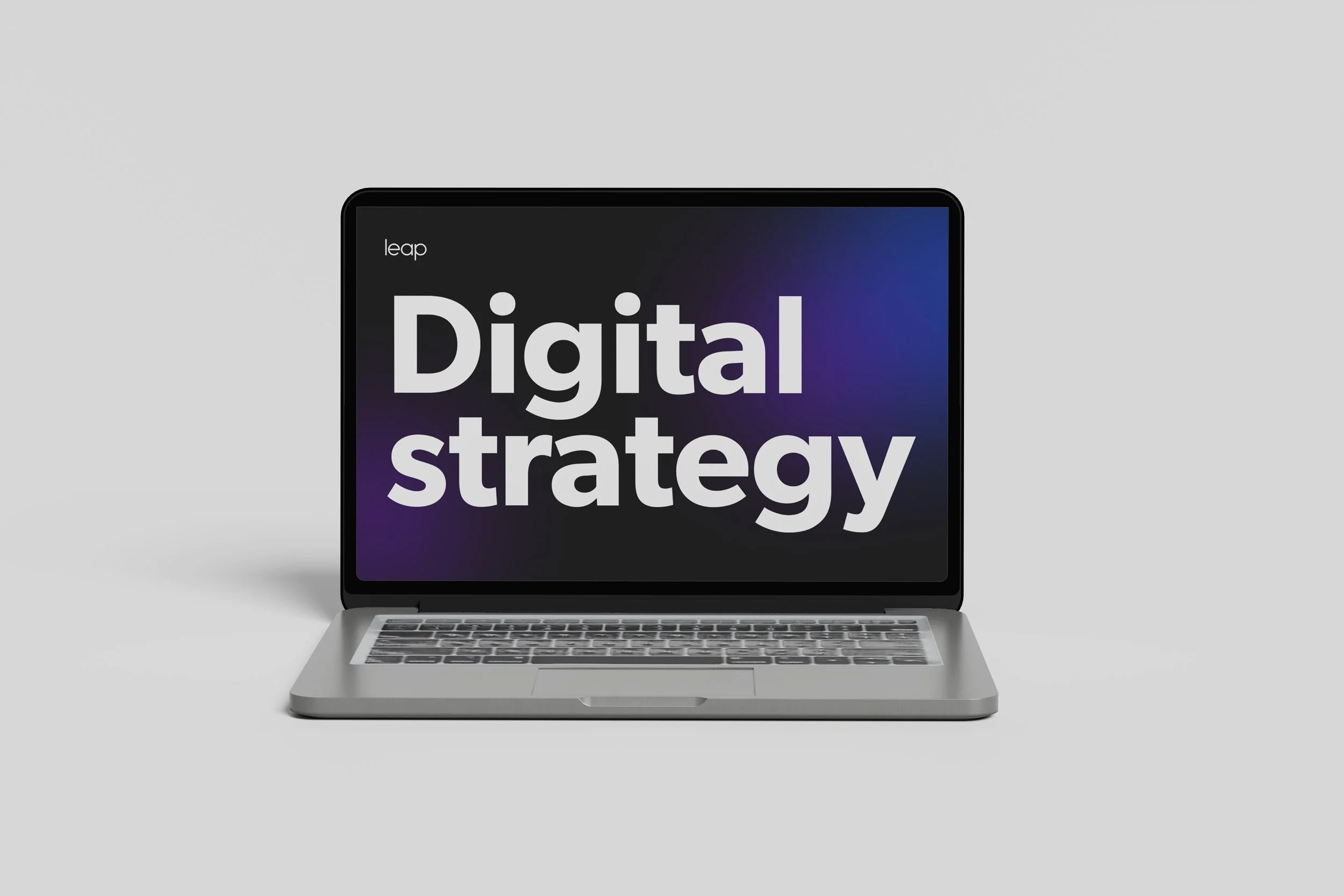♞ Digital Strategy - Case study
CLIENT
Leap agency
SERVICES
SERVICE DESIGN
DESIGN GOVERNANCE
GUIDELINES
CONTENT STRATEGY
SOCIAL MEDIA
Leap’s digital content strategy
Optimising social media strategy to strengthen brand identity and streamline content production for a creative services agency.
The firm’s social media presence was inefficient and misaligned with its business objectives, making it difficult to attract and convert the right audience into clients. Content production was time-consuming and resource-intensive, with no structured approach to maximise impact across platforms.
Through in-depth research and competitor analysis, a strategy was developed to standardise branding, streamline workflows, and optimise content production. A structured framework was introduced to help marketing teams reduce effort while maintaining a cohesive, high-quality brand presence across platforms.
AT A GLANCE
-
Managing social media content for multiple platforms was inefficient and unsustainable due to resource limitations, time-consuming content creation, and a lack of a scalable system.
Branding inconsistencies across platforms weakened the company’s presence, while unclear messaging made it difficult for the audience to understand its service offering. Additionally, a weak online presence and ineffective communication limited engagement and brand visibility.
These challenges resulted in delayed campaigns, inconsistent branding, and difficulty standing out against competitors, highlighting the need for a structured, strategic solution. -
A data-driven strategy was developed to increase content efficiency, refine audience targeting, and enhance brand visibility. By auditing existing content, analysing competitors, and mapping audience preferences, a structured content system was introduced.
New content templates were categorised and recommended to showcase case studies, services, insights, and company updates, ensuring a more strategic and consistent approach.
A circular content strategy was proposed to maximise reach by repurposing content across platforms, optimising production efforts.This approach streamlined workflows, reinforced brand consistency, and positioned the agency in front of the right decision-makers while reducing workload
-
By categorising content needs, streamlining workflows, and proposing a circular content strategy, the project provided a clear roadmap for optimised social media execution.
Strategic content structure – Defined content categories for consistency and impact.
Efficient workflows – Introduced a framework to streamline content creation and reduce effort.
Targeted audience approach – Aligned visual and messaging strategies with key decision-makers.
Scalable content use – Proposed a circular strategy to maximise reach with minimal resources.
Increased internal awareness – Encouraged discussions on using social media as a business tool.
Stronger brand presence – Provided guidance to enhance visual identity and messaging clarity.
While the strategy was not fully implemented, the project delivered practical recommendations and a structured action plan to improve social media efficiency, brand positioning, and audience targeting.
THE PROCESS STEP BY STEP
1
2
3
4
Content Strategy Development
A structured content system was introduced, categorising content types and recommending specific templates to improve engagement. A circular content strategy was proposed to streamline content creation, maximise reach, and reduce workload by repurposing content across platforms.
Research & Problem Identification
An in-depth audit of existing content, competitor strategies, and audience behavior revealed inefficiencies in content production and misalignment with key decision-makers. Practical constraints, such as time and resource limitations, were also assessed to ensure a realistic and scalable strategy.
Final Strategy & Stakeholder Alignment
A comprehensive action plan outlined key findings, proposed solutions, and execution steps to optimise social media strategy. Visual examples demonstrated how content could be structured, repurposed, and aligned with business objectives.
Workflow Optimisation
A scalable workflow model was designed to enhance efficiency and consistency in content production. Practical tools and a visual roadmap were provided to help the team plan, execute, and adapt content seamlessly across multiple platforms.
01 | Research & Insights
What I Did:
To understand the gaps and inefficiencies in the firm’s social media strategy, a comprehensive research phase was conducted. The process involved:
Content Audit: Reviewed all previously published content across social media platforms to identify trends, inconsistencies, and engagement levels.
Audience Analysis: Examined audience demographics, engagement patterns, and social media analytics to determine whether the content aligned with the right target audience (senior executives and decision-makers).
Competitor Benchmarking: Conducted a comparative analysis of industry competitors to assess how their content strategy differed, what worked well, and where the firm could improve.
Efficiency & Workflow Assessment: Identified practical constraints in content production, including time-intensive workflows, resource limitations, and the lack of a structured system for repurposing content.
Key Findings:
Content Misalignment: The current content was not focused on the targeted audience, limiting its effectiveness in reaching key decision-makers.
Brand Inconsistency: Visual and messaging inconsistencies made it harder to establish a strong, recognisable brand identity.
Inefficient Content Production: Creating unique content for each platform was time-consuming and resource-intensive, with no streamlined workflow in place.
Competitor Advantage: Competitors maintained a more structured, targeted content strategy, reinforcing their positioning among high-level decision-makers.
Content Selection Challenges: The lack of defined content categories and templates meant posts were created ad-hoc, often missing strategic goals.
♞ IMPLEMENTATION
02 | Strategy Development
Content Strategy Development
To create a more structured and efficient approach to social media, a content strategy was developed to streamline creation, improve consistency, and maximise engagement.
Defined content categories to streamline creation and maintain consistency.
Recommended specific content templates (e.g., case studies, service overviews, infographics, hiring announcements) to enhance engagement.
Proposed a circular content strategy to repurpose content across multiple platforms, reducing workload while maximising reach.
Workflow Optimisation
To ensure a more efficient and scalable content production process, a structured workflow was developed to streamline execution, improve planning, and maintain brand consistency across platforms. This included:
Optimising content workflows to improve efficiency in planning, creation, and distribution.
Introducing practical content planning tools to help the team organise and execute the strategy effectively.
Developing a visual roadmap to guide content repurposing across platforms while ensuring messaging consistency.
Presentation & Recommendations
A clear action plan was presented to outline key findings and execution steps, ensuring alignment across teams. The recommendations were supported by visual examples, demonstrating how structured content and workflow improvements could drive better engagement and efficiency.
Presented a structured action plan outlining key findings, solutions, and execution steps.
Supplied mockups and content examples to showcase the proposed content structure and distribution model.
Initiated internal discussions on leveraging social media more effectively as a business tool, encouraging future improvements.
♞ RESULTS
03 | Key Improvements
Results
Practical suggestions & Action plan – The agency now had a clear set of recommendations for content types, workflows, and audience engagement strategies.
Clear content structure – The firm now had a defined set of recommended content types, ensuring a more strategic and organised approach to social media.
Scalable workflow model – The proposed circular content strategy introduced a repurposing framework, allowing for more efficient content distribution across platforms.
Visual content alignment – The recommendations outlined how to adjust branding and messaging to attract senior executives and decision-makers more effectively.
Internal awareness & Strategic discussions – The project sparked internal discussions on how to better use social media as a business tool, influencing future content planning efforts.
Key Takeaways
A clear and actionable content strategy was developed, making it easier to create consistent, high-quality content while minimising production time.
The project highlighted the need for a more structured approach to audience engagement, with a focus on both content efficiency and strategic branding.
Although not fully implemented, the project provided a valuable foundation that could be leveraged in future efforts to enhance the firm’s social media impact.




